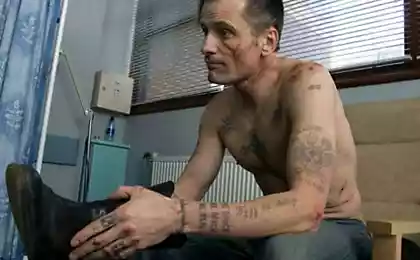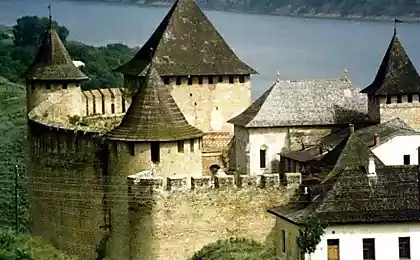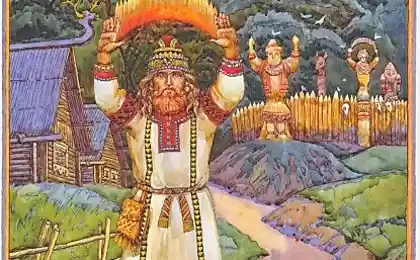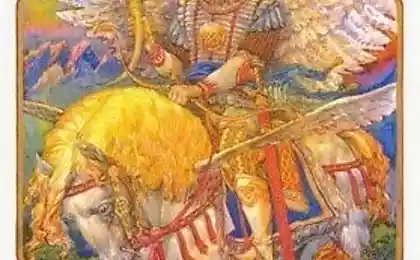1465
Slavic epic heroes and villains
Every childhood tales familiar goblins, Koschei, Baba Yaga and win their Heroes da Ivan Tsarevich different.
We continue to raise the history and heroes of epic (well, and with them of course and villains):

Ilya Muromets (full name of the epic - Ilya Muromets son Ivanovich) - one of the main heroes of the epics of Kievan Rus, the hero who embodies the ideal of the national hero, a warrior people's advocate. It is believed that the birthplace of Ilya Muromets - a village under Karacharovo Moore.

Alyosha Popovich - the son of the Rostov ass Le (c) ontiya (rarely Fedor). All heroes share a common origin from the North-Eastern Russia (Murom, Ryazan, Rostov), a trip to Kiev, conjugate with the fight with the monster, Herculean service in Kiev at the court of Prince Vladimir the Red Sun. Alyosha Popovich distinguished not force (sometimes emphasizes his weakness, indicated his limp, and so on. F.), But the courage, daring, the onslaught on the one hand, and resourcefulness, resourcefulness, cunning, on the other. He was boastful, kichliv, too sly and uvёrtliv; his jokes are sometimes not only fun, but also treacherous, even evil; his fellow heroes at times he expressed his disapproval and condemnation. In general, the image of Alyosha Popovich reflects a certain contradiction and ambiguity.

Nikitich - the second most popular after the epic hero Ilya Muromets Kievan Rus. He is often depicted the serving bogatyrёm Prince Vladimir. Dobrynya is sometimes called the Prince, and sometimes the nephew of Vladimir. He is smart, educated and is varied talents he adroit at leg povёrtok, great shooting, swimming, playing Tavlya, sings, plays the harp.

Nikita Kozhumyaka - In the most complete version (Belarusian and Ukrainian) explains that the prince of Kiev was carried out a serpent's daughter, who loved it, she kept in captivity. Having learned from a snake that he is afraid of only one person - Nikita (or Cyril) Kozhemyako - she dove to her father sends a letter with a request to find this hero, and induce him to fight with the dragon. About
bmotavshis hemp and coat resin to be invulnerable, Nikita bёtsya with kite and releases the prince's daughter.
Belarusian and Ukrainian versions added, imprisoned fairy tale that the tract near Kiev, where he lived hero, has since become known as Kozhemyako. Great-version is slightly different ending. Snake overturned Nikita Kozhemyako, begs him for mercy and offers to share his land equally. Nikita forged plow 300 pounds, harnessed to her snake and spent furrow from Kiev to the sea; then began to divide the sea, he killed the snake and sank his body. Remains from the furrow tillage Nikita visible now; these "serpents" shafts are still listed in some places in Ukraine. Svyatogor - Russian hero epos, standing outside of Kiev and Novgorod cycles and only partly in contact with the first meeting in the epics Svyatogora with Ilya Muromets.
Svjatogor in the epic is a huge giant, "standing above the forest"; it is difficult mother-land of cheese. He does not go to Holy Russia, and lives in high mountains of the Saints; during his trip to the mother-land of cheese stunning swaying forests and rivers poured their banks.

Mikula Selyaninovich - character of Russian tales, the hero, the legendary plowman.
It represents peasant power, the power of the Russian people. According to one of tales, he asked the giant Svyatogora raise the fallen to the ground a bag. He can not cope with the task. Then Mikula Selyaninovich raises the bag with one hand, indicating that it is "the entire burden of the earth," that only by peaceful, hard-working plowman.
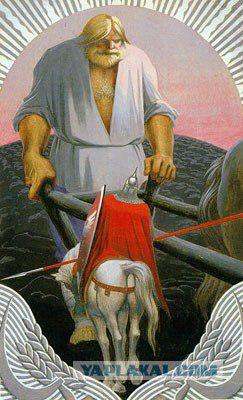
Volga Svyatoslavich (also Volh Vseslav'evich) - hero, a character Russian epics. The main distinguishing feature of the Volga is a trick, the ability to shape-shifting and the ability to understand the language of birds and animals. Ivan Tsarevich - one of the main characters of Russian folklore. As the fairy tale character, he appeared in the late XVIII-early XIX century.
Ivan Tsarevich appears in fairy tales in two different guises:
• positive character, fighting against evil to help an injured or weak. Very often, at the beginning of a fairy tale Ivan Tsarevich poor, lost parents, persecuted by enemies, is not aware of his royal origin. In such tales as a reward for heroic behavior and good deeds Ivan Tsarevich he get back his kingdom, his throne, and is the royal parents. But even if it was originally prince, the end of the story, he usually gets a prize in the form of a kind of alien kingdoms, the royal and the royal daughter, magic or expensive horse, precious or magic items or even additional mind or magical abilities.
• negative character, which is opposed to the other princes, but most characters of humble origin, for example, Ivan, son of the fishing. In this case, Prince Ivan angry, cunning and different ways of trying to destroy the goodies and take from them a well-deserved award. At the end it is put to shame and punishment, but almost never - killed.

Ivan the Fool or Ivan the Fool - one of the main prototypical characters of Russian fairy tales. By Dumb versions of the name Ivan the Fool is the name of Charm, preventing the evil eye. It embodies a special fairy strategy emanating not from the standard postulates of practical reason, based on the search for their own solutions, often contradictory to common sense, but, ultimately bringing success.

And now, the villains:
Bag of Bones (Kashchei Immortal) - negative character of Russian fairy tales in Russian folklore. King, sometimes - a rider on a horse magical speaking. Often it is acting as a captor of the bride of the protagonist. It depicted as a thin tall old man, often represented skryazhistym and stingy
• Water reports Koscheyu supernatural power. After drinking three pails of water brought to him Ivan Tsarevich, Koschey breaks the chains 12 and released from the dungeon Mary Morevna.
• Death Koshchey hidden on the island of Buyan (according to some interpretations, it is the island of Ruegen [source not specified 38 days]), which is growing oak, hanging on an oak chest in the trunk rabbit, hare in a duck in a duck egg, the egg needle. If you break the needle, then Koschey die. There is also a version according to which Koschey receives death by his magical horse. While there may be death by a horse is an earlier version [source not specified 38 days].
• Daughter Koshchey acts Vasilisa (from the Greek. Basilissa - queen) Wise (aka Princess Frog), a different version of the father Vasilisa the Wise King of the Sea. The image of the "kings of the sea" goes back to the image of sea-king - German leaders sea voyages era Dark Ages (from ready to Vikings), who came from Scandinavia. It is noteworthy that the kingdom Koshchey localized in the north.

Source:
We continue to raise the history and heroes of epic (well, and with them of course and villains):

Ilya Muromets (full name of the epic - Ilya Muromets son Ivanovich) - one of the main heroes of the epics of Kievan Rus, the hero who embodies the ideal of the national hero, a warrior people's advocate. It is believed that the birthplace of Ilya Muromets - a village under Karacharovo Moore.

Alyosha Popovich - the son of the Rostov ass Le (c) ontiya (rarely Fedor). All heroes share a common origin from the North-Eastern Russia (Murom, Ryazan, Rostov), a trip to Kiev, conjugate with the fight with the monster, Herculean service in Kiev at the court of Prince Vladimir the Red Sun. Alyosha Popovich distinguished not force (sometimes emphasizes his weakness, indicated his limp, and so on. F.), But the courage, daring, the onslaught on the one hand, and resourcefulness, resourcefulness, cunning, on the other. He was boastful, kichliv, too sly and uvёrtliv; his jokes are sometimes not only fun, but also treacherous, even evil; his fellow heroes at times he expressed his disapproval and condemnation. In general, the image of Alyosha Popovich reflects a certain contradiction and ambiguity.

Nikitich - the second most popular after the epic hero Ilya Muromets Kievan Rus. He is often depicted the serving bogatyrёm Prince Vladimir. Dobrynya is sometimes called the Prince, and sometimes the nephew of Vladimir. He is smart, educated and is varied talents he adroit at leg povёrtok, great shooting, swimming, playing Tavlya, sings, plays the harp.

Nikita Kozhumyaka - In the most complete version (Belarusian and Ukrainian) explains that the prince of Kiev was carried out a serpent's daughter, who loved it, she kept in captivity. Having learned from a snake that he is afraid of only one person - Nikita (or Cyril) Kozhemyako - she dove to her father sends a letter with a request to find this hero, and induce him to fight with the dragon. About
bmotavshis hemp and coat resin to be invulnerable, Nikita bёtsya with kite and releases the prince's daughter.
Belarusian and Ukrainian versions added, imprisoned fairy tale that the tract near Kiev, where he lived hero, has since become known as Kozhemyako. Great-version is slightly different ending. Snake overturned Nikita Kozhemyako, begs him for mercy and offers to share his land equally. Nikita forged plow 300 pounds, harnessed to her snake and spent furrow from Kiev to the sea; then began to divide the sea, he killed the snake and sank his body. Remains from the furrow tillage Nikita visible now; these "serpents" shafts are still listed in some places in Ukraine. Svyatogor - Russian hero epos, standing outside of Kiev and Novgorod cycles and only partly in contact with the first meeting in the epics Svyatogora with Ilya Muromets.
Svjatogor in the epic is a huge giant, "standing above the forest"; it is difficult mother-land of cheese. He does not go to Holy Russia, and lives in high mountains of the Saints; during his trip to the mother-land of cheese stunning swaying forests and rivers poured their banks.

Mikula Selyaninovich - character of Russian tales, the hero, the legendary plowman.
It represents peasant power, the power of the Russian people. According to one of tales, he asked the giant Svyatogora raise the fallen to the ground a bag. He can not cope with the task. Then Mikula Selyaninovich raises the bag with one hand, indicating that it is "the entire burden of the earth," that only by peaceful, hard-working plowman.

Volga Svyatoslavich (also Volh Vseslav'evich) - hero, a character Russian epics. The main distinguishing feature of the Volga is a trick, the ability to shape-shifting and the ability to understand the language of birds and animals. Ivan Tsarevich - one of the main characters of Russian folklore. As the fairy tale character, he appeared in the late XVIII-early XIX century.
Ivan Tsarevich appears in fairy tales in two different guises:
• positive character, fighting against evil to help an injured or weak. Very often, at the beginning of a fairy tale Ivan Tsarevich poor, lost parents, persecuted by enemies, is not aware of his royal origin. In such tales as a reward for heroic behavior and good deeds Ivan Tsarevich he get back his kingdom, his throne, and is the royal parents. But even if it was originally prince, the end of the story, he usually gets a prize in the form of a kind of alien kingdoms, the royal and the royal daughter, magic or expensive horse, precious or magic items or even additional mind or magical abilities.
• negative character, which is opposed to the other princes, but most characters of humble origin, for example, Ivan, son of the fishing. In this case, Prince Ivan angry, cunning and different ways of trying to destroy the goodies and take from them a well-deserved award. At the end it is put to shame and punishment, but almost never - killed.

Ivan the Fool or Ivan the Fool - one of the main prototypical characters of Russian fairy tales. By Dumb versions of the name Ivan the Fool is the name of Charm, preventing the evil eye. It embodies a special fairy strategy emanating not from the standard postulates of practical reason, based on the search for their own solutions, often contradictory to common sense, but, ultimately bringing success.

And now, the villains:
Bag of Bones (Kashchei Immortal) - negative character of Russian fairy tales in Russian folklore. King, sometimes - a rider on a horse magical speaking. Often it is acting as a captor of the bride of the protagonist. It depicted as a thin tall old man, often represented skryazhistym and stingy
• Water reports Koscheyu supernatural power. After drinking three pails of water brought to him Ivan Tsarevich, Koschey breaks the chains 12 and released from the dungeon Mary Morevna.
• Death Koshchey hidden on the island of Buyan (according to some interpretations, it is the island of Ruegen [source not specified 38 days]), which is growing oak, hanging on an oak chest in the trunk rabbit, hare in a duck in a duck egg, the egg needle. If you break the needle, then Koschey die. There is also a version according to which Koschey receives death by his magical horse. While there may be death by a horse is an earlier version [source not specified 38 days].
• Daughter Koshchey acts Vasilisa (from the Greek. Basilissa - queen) Wise (aka Princess Frog), a different version of the father Vasilisa the Wise King of the Sea. The image of the "kings of the sea" goes back to the image of sea-king - German leaders sea voyages era Dark Ages (from ready to Vikings), who came from Scandinavia. It is noteworthy that the kingdom Koshchey localized in the north.

Source:








